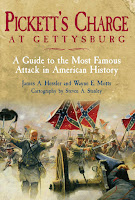I am often asked about the state of Civil War publishing. Here is an article I put together, which made the front page of Civil War News a while back. I hope you enjoy it. -- tps

Advances in technology in general and the advent
of faster computers, better software and the Internet in particular have turned
every aspect of publishing inside-out.
The past couple of decades have witnessed radical change in the world of book
publishing. Nothing has been left untouched, from how books are researched,
written, designed, submitted, printed and proofed to how they are marketed,
purchased, delivered and even how they are read.
Many people I speak with in and out of the publishing industry lament these
changes, but I am not one of them because I believe readers have benefited the
most from this technological tsunami.
Today, we readers have at our fingertips access to the broadest selection of
Civil War titles we have ever enjoyed. We can order them from catalogs, purchase
them in brick-and-mortar stores and at battlefields, buy directly from
publishers, authors, or online stores with a few clicks.
We can even download them into our reading devices. We can read them in
traditional print, listen to some on audio, or access them through digital
handheld devices or on our home or office computers.
The breadth and depth of the subject matter has never been richer. Indeed, the
giant smorgasbord of titles at which we feast adds credence to the slogan “So
many books, so little time.” Gettysburg continues to overwhelm, but many of the titles on
that well-tread subject break new ground.
The Western Theater is finally getting some of the attention it deserves with
fresh studies on Shiloh, the battles around Atlanta, Stones River, and a wide variety of books on the various
commanders and regiments that made it all possible.
Even the Trans-Mississippi Theater, the war’s redheaded stepchild, has been
the subject of new studies. Indeed, no category under “Civil War” is lacking
for new books.

This plethora of titles is the result of Internet-related technologies that
have made research substantially easier, and cheaper, and the desktop publishing
and its related software and spin-offs that came along with it, all of which combined to remove most of the entry barriers
into the publishing world.
In the past, the only viable way to conduct adequate research was to personally
visit the repositories of primary material (National Archives, Library of
Congress, state historical societies, and so forth). Although I do not believe
there is a substitute for personal research “in the stacks,” much of what we
need is now available at our fingertips through the Internet.
Entire books (including many of the hard-to-find regimental histories) are now
available free online, as are the Official Records and many other
databases, documents, photographs, roster data and genealogical sources.
Combine this steep reduction in time and money regarding research with desktop
publishing software that turns whatever you produce into at least something
that looks like a book. The result is more books than you could ever read in
your lifetime.
The spigot really opened with the advent of print-on-demand (POD). Traditional
printing injects ink into the paper and requires a sizable number of copies to
make it worthwhile to set up the press (1,500 or higher). POD, however, is a
high resolution copier that puts toner on the paper.

With POD, you can produce a single copy or 1,000 copies, as needed. The expense
per copy can get pretty steep, but there is no need to tie up thousands of
dollars and warehouse space on inventory.
In addition, POD quality has improved so dramatically over the past half-dozen
years that most people can no longer tell the difference. The physical quality
of a book, however, has no relationship to the quality of the research, the
writing, the editing, the organization or the presentation.
The merger of these technologies has been tremendous for readers of Civil War
history. The rapid expansion of available titles, however, makes the Latin
warning caveat emptor (“Let the buyer beware”) all the more
relevant.
Anytime something is easier to do, more people will do it. This is
overwhelmingly true in two publishing areas: any fiction in any genre — and
anything related to the Civil War.
Exercise Discretion and Care when Buying Your Books
Without many of the traditional “roadblocks” in place, like agents, acquisition editors, developmental editors, copy editors, peer review, and so forth, it is more important than ever to exercise discretion before purchasing a book. If, in your opinion, the publisher and author have a good track record, a catalog description and announcement could be enough.
Track records matter, whether it’s a car brand or a publisher. If this relationship is not present, and good research is important to you, then what’s in the bibliography?
Is the book footnoted? Is the material edited
well and presented in an attractive, organized readable format? Is the book
indexed? Is it well written? Can you read an excerpt before purchasing it?
What is important to you? This question is more important today than it has ever been.
 With all due respect to the giants of yesteryear, Civil War books (in terms of
research, writing, design, printing, and binding) have never been better.
Indeed, the best material (in a secondary sense) is being published right
now.
With all due respect to the giants of yesteryear, Civil War books (in terms of
research, writing, design, printing, and binding) have never been better.
Indeed, the best material (in a secondary sense) is being published right
now.
We are living through the golden age of Civil War publishing. Pull down one of
your favorites from the 1940s, 50s or 60s, and compare it to one of your
favorites of today, and you will immediately see what I mean.
There are always exceptions. The pens of many brilliant writers and thinkers we
hold dear went still many decades ago. Douglas Southall Freeman, Allan Nevins,
Edwin Coddington, and Bruce Catton, among others, leap readily to mind. These
men will always be in the pantheon of the magnificent. Indeed, all of us stand
on their shoulders and owe them a debt of gratitude we can never repay.
However, a large percentage of the rest of the titles published in their day —
some of which we still regard as “classics” — are, like many of the movies of
our younger years, not quite as good as we remember them to be.
Hundreds of Civil War-related titles will be published this year and hundreds
more next year and the year after. Because it is easier now than it has ever
been to research and produce books, the smorgasbord table from which we read
will always be a bounty of riches for those with the patience to choose wisely.

